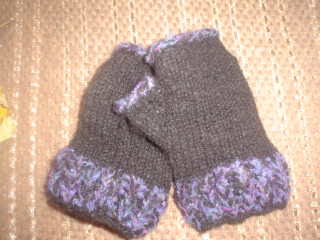
Today I commented on someone's blog that I would put pictures of my own half mitts on my blog so here they are! Not as pretty as her mitts were, whoever you were! Ph.d something? Anyway, she had these absolutely lovely mitts pictured on her blog that were very inspiring. Mine are knitted differently, and have been worn many times. The black yarn is from my purebred Shetland ewe "Mona". She is a beautiful black with an intermediate staple length. Her fleece is very fine and soft, perfect for mitts that don't need to be super durable. I knitted a 1:1 rib for the cuff with an accent yarn stranded along the black yarn (to compensate for the gauge change, I cast on fewer rib stitches, then increased just after the cuff, evenly), of which I spun into a worsted weight 2-ply that is very lightweight. I also picked up the accent yarn for the end over the fingers and thumb (this gauge change works in your favor by adding space as long as you don't make your bind off too tight). They match my "off farm" coat and are fun to have. I've also sold many of them. (Another Shetland breeder I visited today had commented about going to farm markets, maybe. These mitts are fast and easy to knit up, and sell well, so if you are reading this, consider mitts as part of your inventory. You can do sooo much with adding color and spinning before knitting! The possibilities are endless, as well as patterns.) People love them for computer jobs (to keep wrists and hands warm while keyboarding) and cold office buildings. Others like them for ease in driving or shopping as you're fingers are available to pay, whatever. One student commented that they were "smokers"...meaning to be worn by students outside smoking. Didn't like that one. :(

This pair is the same "wing-it" pattern as the black ones above, but in a dark brown purebred Shetland ewe that I don't own. I spun this into a two-ply worsted as well, and the accent yarn stranded along with the dark brown is a singles yarn left over from spinning a ball of roving called "Raindrops on Roses" by Psalm 23 Farm. These are my barn mitts, that's why they are full of hay! The colors match my barn coat. I've worn them for two winters now. On bitterly cold days, I wear them under my wool mittens for double coziness.
Ok, back to breeding. Horns for me are not really a goal, so here I go!
It's currently popular to breed for polled rams. It's also not unusual to have an occassional polled ram in the Shetland breed. The first few years I researched sheep and visited farms, I realized I needed to think about horns and address the issue in my flock plan. So I carefully thought about 2 things:
1. What is a genuine shetland? and
2. Where do I, my family, and my farm fit into that?
After much discussion and careful pondering, I concluded that horns would be best in our flock. While I'm not looking forward to farm remodeling by my horned rams, polled rams remodel, too! Most importantly, I want visitors to my farm be able to easily spot a ram coming their way by seeing his horns. (We have lots of visitors, and kids, coming by.) We've heard of polled rams mistakenly getting into the ewe group unnoticed and people getting whacked by surprise, or ewes being bred to rams you didn't want to group with, etc. We've also heard of one shepherdess who couldn't get her ewes to take to a polled ram. Seems all the girls thought the horned ram on the other side of the the farm was better looking, or something! Since we have many visitors, and kids around, and since we plan on keeping a low number of intact rams around, we've chosen to go with horns. That way, the rams will be able to defend themselves from each other if need be.
So we've concluded that:
a) rams need their horns for social order, social maintanence of their group, for defense, and for attraction
b) as humans, we can remodel barns and fences ourselves. However, remodeling our bodies would be harder. Horns give you a clue if you should be watching your surroundings better.
c) rams with horns can be good-looking, and ewes like that, too (although, I sure some ewes wouldn't care either way, right)
Therefore, horns are not in our goals because a polled ram can pop up, and one of my ewes might carry that. If any ram lambs are polled, well, we have a plan in place on how we would assess the situation, and act then. Chances are good he'd be wethered and maintained as fleece producer for our business, and double duty as a buddy.
I forgot to say that my mitts were knitted in the round. Lots of mitt patterns can be knitted flat, on straight needles, then sewn up, too.
ReplyDelete